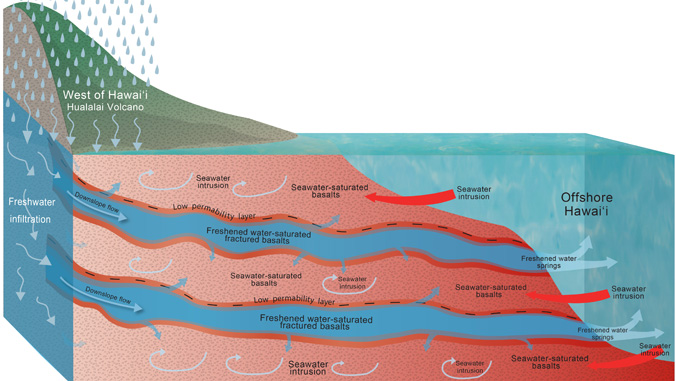
HONOLULU (Eagle News) – Twice as much freshwater is stored offshore of Hawaii’s Big Island than previously thought, according to a University of Hawaii (UH) study with important implications for volcanic islands around the world.
The groundbreaking findings, published in Science Advances, reveal a novel way in which substantial volumes of freshwater are transported from onshore to offshore submarine aquifers along the coast of Big Island.
This mechanism may provide alternative renewable resources of freshwater to volcanic islands worldwide.
“Their evidence for separate freshwater lenses, stacked one above the other, near the Kona coast of Hawaii, profoundly improves the prospects for sustainable development on volcanic islands,” said UH Mānoa School of Ocean and Earth Science and Technology (SOEST) Dean Brian Taylor.
Through the use of marine controlled-source electromagnetic imaging, the study revealed the onshore-to-offshore movement of freshwater through a multilayer formation of basalts embedded between layers of ash and soil, diverging from previous groundwater models of this area.
Conducted as a part of the National Science Foundation (NSF)-supported ʻIke Wai project, research affiliate faculty Eric Attias led the marine geophysics campaign.
“Our findings provide a paradigm shift from the conventional hydrologic conceptual models that have been vastly used by multiple studies and water organizations in Hawaii and other volcanic islands to calculate sustainable yields and aquifer storage for the past 30 years,” said Attias. “We hope that our discovery will enhance future hydrologic models, and consequently, the availability of clean freshwater in volcanic islands.”
Co-author Steven Constable, a professor of geophysics at the Scripps Institution of Oceanography, who developed the controlled source electromagnetic system used in the project, said, “I have spent my entire career developing marine electromagnetic methods such as the one used here. It is really gratifying to see the equipment being used for such an impactful and important application. Electrical methods have long been used to study groundwater on land, and so it makes sense to extend the application offshore.”
Donald Thomas, a geochemist with the Hawaii Institute of Geophysics and Planetology in SOEST who also worked on the study, said the findings confirm two-times the presence of much larger quantities of stored groundwater than previously thought.
“Understanding this new mechanism for groundwater…is important to better manage groundwater resources in Hawaii,” said Thomas, who leads the Humuʻula Groundwater Research project, which found another large freshwater supply on Big Island several years ago.
Offshore freshwater systems similar to those flanking the Hualālai aquifer are suggested to be present for the island of Oahu, where the electromagnetic imaging technique has not yet been applied, but, if demonstrated, could provide an overall new concept to manage freshwater resources.
The study proposes that this newly discovered transport mechanism may be the governing mechanism in other volcanic islands. With offshore reservoirs considered more resilient to climate change-driven droughts, volcanic islands worldwide can potentially consider these resources in their water management strategies.
(With reports from EBC Hawaii Bureau, Eagle News Service)
